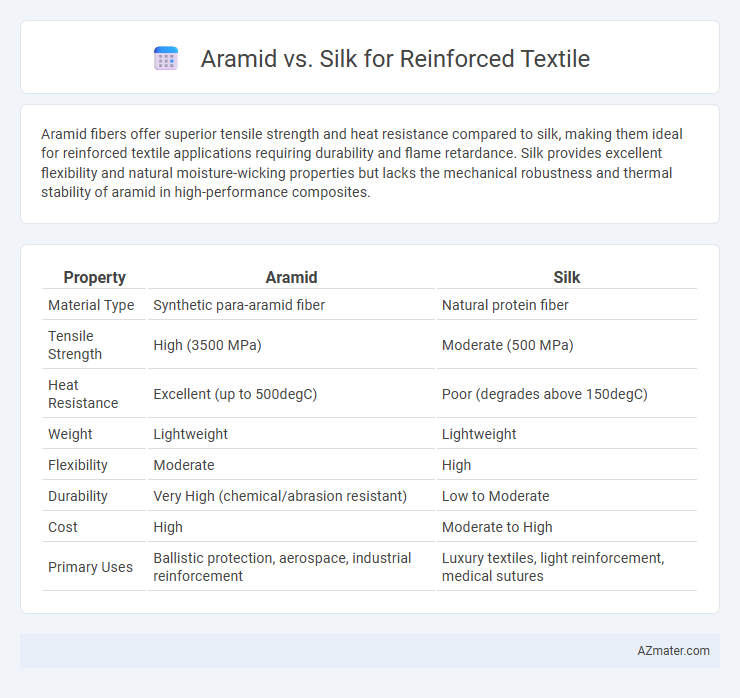Aramid fibers offer superior tensile strength and heat resistance compared to silk, making them ideal for reinforced textile applications requiring durability and flame retardance. Silk provides excellent flexibility and natural moisture-wicking properties but lacks the mechanical robustness and thermal stability of aramid in high-performance composites.
Table of Comparison
| Property | Aramid | Silk |
|---|---|---|
| Material Type | Synthetic para-aramid fiber | Natural protein fiber |
| Tensile Strength | High (3500 MPa) | Moderate (500 MPa) |
| Heat Resistance | Excellent (up to 500degC) | Poor (degrades above 150degC) |
| Weight | Lightweight | Lightweight |
| Flexibility | Moderate | High |
| Durability | Very High (chemical/abrasion resistant) | Low to Moderate |
| Cost | High | Moderate to High |
| Primary Uses | Ballistic protection, aerospace, industrial reinforcement | Luxury textiles, light reinforcement, medical sutures |
Overview of Reinforced Textiles
Aramid fibers, such as Kevlar and Twaron, are synthetic materials known for exceptional tensile strength, heat resistance, and durability, making them ideal for reinforced textiles in protective gear and aerospace applications. Silk, a natural protein fiber, offers high tensile strength and flexibility but falls short in heat resistance and environmental durability compared to aramid fibers. Reinforced textiles utilizing aramid provide superior mechanical performance and longevity, whereas silk-based textiles are valued for their biodegradability and lightweight properties in specialized uses.
Introduction to Aramid Fibers
Aramid fibers, known for their exceptional strength-to-weight ratio and high thermal resistance, are widely used in reinforced textiles for applications requiring durability and protection. These synthetic fibers exhibit superior tensile strength, chemical resistance, and dimensional stability compared to natural fibers like silk. Their inherent flame-retardant properties and resistance to abrasion make aramid fibers an ideal choice for advanced composite materials and protective clothing.
Introduction to Silk Fibers
Silk fibers, derived from the protein fibroin produced by silkworms, are renowned for their exceptional tensile strength, elasticity, and smooth texture, making them a valuable component in reinforced textiles. Unlike synthetic aramid fibers, silk offers superior biodegradability and natural moisture-wicking properties, enhancing comfort and environmental sustainability. Its unique molecular structure provides a balance of lightweight flexibility and durability, which supports innovative applications in advanced textile composites.
Mechanical Properties: Aramid vs Silk
Aramid fibers exhibit superior tensile strength and exceptional resistance to abrasion compared to silk, making them ideal for reinforced textiles requiring high durability and impact resistance. Silk offers remarkable flexibility and elasticity, providing enhanced tear resistance and lightweight properties but falls short in withstanding extreme mechanical stresses. The choice between aramid and silk depends on the specific mechanical property requirements, with aramid favored for high-strength applications and silk for lightweight, flexible textiles.
Durability and Chemical Resistance Comparison
Aramid fibers, such as Kevlar, exhibit superior durability compared to silk due to their high tensile strength and excellent resistance to abrasion, making them ideal for reinforced textiles used in protective gear and industrial applications. Chemically, aramid fibers withstand exposure to most organic solvents, oils, and mild acids, whereas silk degrades more rapidly when exposed to alkalis, strong acids, and some chemicals. The enhanced chemical resistance and long-term durability of aramid ensure better performance and longevity in harsh environmental conditions compared to natural silk.
Weight and Comfort Considerations
Aramid fibers, known for their high strength-to-weight ratio, offer exceptional durability while remaining relatively lightweight compared to traditional textiles, making them ideal for reinforced applications where weight is critical. In contrast, silk provides superior comfort due to its natural softness and breathability but lacks the enhanced tensile strength and abrasion resistance of aramid materials. Choosing between aramid and silk for reinforced textiles depends on balancing the need for lightweight performance with wearer comfort, as aramid excels in protective roles while silk favors ergonomic applications.
Performance in Extreme Conditions
Aramid fibers exhibit superior heat resistance and tensile strength compared to silk, making them ideal for reinforced textiles used in extreme conditions such as firefighting and aerospace applications. Silk offers excellent flexibility and moisture-wicking properties but lacks the thermal stability and abrasion resistance of aramid. For high-performance environments requiring durability under intense heat and mechanical stress, aramid-based textiles provide unmatched reliability and safety.
Cost and Availability Analysis
Aramid fibers, such as Kevlar, are significantly more expensive than silk due to their complex synthetic production processes and high-performance capabilities in reinforced textiles. Silk, a natural fiber, offers greater availability through established sericulture industries, resulting in lower costs and easier sourcing for textile manufacturers. Cost-effectiveness and supply chain stability make silk a preferred material in applications where moderate strength suffices, while aramid remains essential for high-strength, impact-resistant uses despite its higher price and limited availability.
Applications in Industry and Fashion
Aramid fibers offer exceptional strength, heat resistance, and durability, making them ideal for industrial applications such as aerospace, automotive, and protective clothing where high-performance reinforcement is essential. Silk, characterized by its natural luster, flexibility, and comfort, is favored in fashion for luxury textiles, high-end garments, and accessories that require both aesthetic appeal and moderate durability. The choice between aramid and silk hinges on balancing performance demands with visual and tactile qualities, with aramid dominating technical uses and silk excelling in premium fashion contexts.
Sustainability and Environmental Impact
Aramid fibers, known for their high strength and heat resistance, have a significant environmental footprint due to energy-intensive production processes and reliance on non-renewable petrochemicals. In contrast, silk is a natural, biodegradable fiber produced through sericulture, offering a more sustainable and eco-friendly option despite concerns over the ethical treatment of silkworms. Evaluating reinforced textiles, silk's renewable nature and lower carbon emissions present a greener alternative, whereas aramid's durability and performance contribute to longer product life cycles, partially offsetting its environmental impact.

Infographic: Aramid vs Silk for Reinforced Textile
 azmater.com
azmater.com